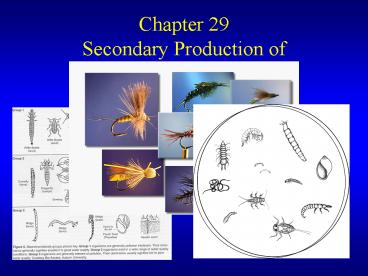Chapter 29 Secondary Production of Macroinvertebrates - PowerPoint PPT Presentation
1 / 9
Title:
Chapter 29 Secondary Production of Macroinvertebrates
Description:
A = P R U. Where: I= ingestion, A= assimilation, F= food that is defecated(egestion), P= production, R= respiration, and. U= excretion ... – PowerPoint PPT presentation
Number of Views:35
Avg rating:3.0/5.0
Title: Chapter 29 Secondary Production of Macroinvertebrates
1
Chapter 29 Secondary Production of
Macroinvertebrates
2
Introduction
- Secondary Production formation of heterotrophic
biomass through time - I A F
- A P R U
- Where I ingestion, A assimilation,
- F food that is defecated(egestion),
- P production, R respiration, and
- U excretion
3
Introduction Continued
- Growth
- How much is eaten
- How efficiently is food converted
- Efficiency
- Assimilation efficiency (A/I)
- 5 detritivores
- 90 carnivores
- Net production efficiency (P/A)
- 50 detritivores
- 50 carnivores
4
Biomass Turnover and the P/B Concept
- Biomass (B) how much living tissue mass for a
population is present at one instant in time
(g/m2) - Production (P) is a flow (g/m2time)
- P/B is a rate (1/time)
- Can be associated with individual or cohorts
- Cohort group or population
5
Utility of Secondary Production in Ecosystem
Studies
- Studies of secondary production
- Levels of production
- Physical and biological control factors,
- Estimates for assessing aspects of bioenergetic,
and performance of a population or interactions
with other members of the community - Used as a response variable in experimental
studies - Biotic interactions,
- Whole system manipulations, and
- Effects of land use on stream communities
6
General Design
- Focused on specific habitat or a stream reach
- Requires many samples throughout the year
7
Design Continued
- Density number of organisms in a given area
- Size-Structure density of individuals within
each size class of a population - Length-specific mass (mg) and Density (/area)
- Size specific biomass (mg/area)
- Population biomass sum of biomass for all sizes
- A lot of these measurements can be found in the
Lit.
8
Application
9
Application































